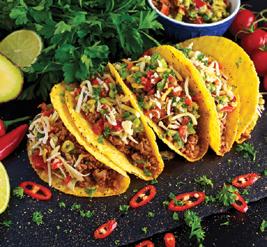
3 minute read
Six Sodium Surprises
Six Sodium Surprises
Surprising foods that add the most sodium to diets
By American Heart Association Sodium Reduction Initiative Team
Did you know that a lot of common foods add more sodium to your diet than you might think? It’s not just the French fries and pretzels you need to watch out for.
That’s why the American Heart Association/American Stroke Association created the “Salty Six”—to show you the top six foods that contribute the most sodium to diets. Even though these foods don’t necessarily taste salty, the sodium they have can add up when eaten frequently. And most of the sodium being digested (about three quarters) is already in the food before purchased. That means that it’s not as much about how we handle the salt shaker as it is about what is already in our food.
Take a look at the foods in the Salty Six. Too much sodium is bad news for your heart health. It’s bad news for your appearance, too: extra sodium can make your body retain water, which can make your face feel puffy, give you bags under your eyes, increase swelling in your fingers, and make your jeans look and feel tighter.
A key point is that different brands and restaurant versions of the same kinds of foods can vary widely in sodium content. Compare nutrition labels, and choose products with the lowest amounts of sodium per serving.
You can also look for the American Heart Association’s Heart-Check mark at grocery stores and some restaurants to find foods that can be part of an overall healthy diet. With a little nutrition label know-how, you’ll be well on your way to healthier choices. ■
1) Cold cuts and cured meats.
Deli or prepackaged turkey can have as much as 1,050 milligrams of sodium per serving. Some sodium is added, because these meats would spoil quickly without the added sodium solution, but it doesn’t need to be excessive. If you compare nutrition labels and look for lower sodium varieties, you will find that they are out there.
2) Pizza.

Pizza isn’t exactlyknown for being a healthy food, but you’re probably thinking the big concerns here are saturated fatand calories. But did you know that one slice may have up to 760 milligrams of sodium? It doesn’t take a lot of math to realize that a few slices can send sodium skyrocketing. Top your slices with more veggies and less cheese, and swap in a salad for some of your slices.
3) Soup.

Soup can’t be bad if mom gave it to you for the sniffles, right? Well, one cup of canned chicken noodle soup can contain up to 940 milligrams of sodium. Make a big batch of your own and freeze the leftovers, or add plain frozen veggies to a lower-sodium variety of canned soup, so there is less sodium per serving.
4) Breads and rolls.
A lot of bread doesn’t even taste salty, but one piece can have as much as 230 milligrams of sodium. If you have toast for breakfast, a sandwich for lunch and dinner rolls, that can add up quickly. Thinner slices tend to have fewer calories, and less sodium as well.
5) Chicken.

Reasonable portions of lean, skinless grilled chicken are great. But nuggets tend to have a lot of added salt, and even fresh poultry is often injected with added sodium solutions. Just three ounces of frozen and breaded nuggets (about the size of the palm of your hand) can add nearly 600 milligrams of sodium. Check the label to find out if your poultry has been plumped up with a salt solution—a four ounce serving shouldn’t have more than 100 milligrams of sodium.
6) Burritos and Tacos.

Did you know that two teaspoons of packaged taco seasoning can have 411 milligrams of sodium? There are so many ways to build a better taco with less sodium and big flavor. Instead of store-bought seasoning, you can make your own by combining ½ teaspoon each of cumin, oregano, chili powder and garlic powder, for a total of 42 milligrams of sodium.










